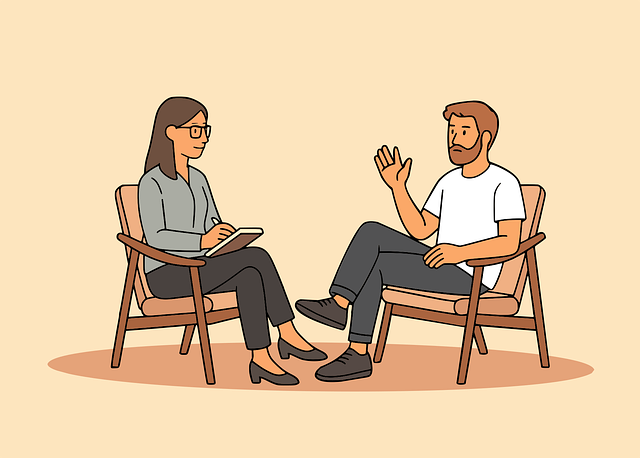Cognitive Behavioral Therapy (CBT) is a goal-oriented psychotherapy that focuses on negative thought patterns and behaviors, aiming to improve emotional well-being and life outcomes. By combining techniques like cognitive restructuring, collaborative goal setting, structured action plans, and dynamic progress tracking, CBT equips individuals with tools to challenge distorted cognitions, adopt healthier thinking, and implement adaptive behaviors. This process enhances self-awareness, boosts resilience, and motivates clients towards successful goal achievement. Integrated therapeutic approaches, including ACT or mind-body practices, further optimize outcomes by addressing multifaceted client needs.
“Goal-oriented psychotherapy, particularly through Cognitive Behavioral Therapy (CBT), offers a structured approach to personal growth and well-being. This article delves into the core principles of CBT as a foundation for goal-directed therapy, exploring its effectiveness in helping individuals achieve desired outcomes. We examine cognitive restructuring techniques, setting measurable objectives, motivating clients, tracking progress, and integrating diverse therapeutic methods. By understanding these key elements, mental health professionals can enhance their practice and guide clients towards successful goal achievement.”
Understanding CBT Therapy: A Foundation for Goal-Oriented Psychotherapy

Cognitive Behavioral Therapy (CBT) serves as a foundational approach within goal-oriented psychotherapy. It focuses on identifying and modifying negative thought patterns and behaviors that hinder individuals from achieving their desired goals. CBT therapy encourages clients to challenge distorted cognitions, develop healthier thinking habits, and adopt more adaptive behaviors, ultimately leading to positive changes in emotional well-being and life outcomes.
By employing evidence-based techniques, CBT helps individuals set realistic objectives and create structured action plans. Through collaborative goal setting and regular assessment, therapists support clients in navigating challenges and celebrating achievements along their therapeutic journey. This data-driven approach ensures that the psychotherapy remains focused and effective, empowering individuals to take ownership of their personal growth and reach their full potential.
The Role of Cognitive Restructuring in Achieving Personal Goals

Cognitive restructuring, a key component of CBT (Cognitive Behavioral Therapy) therapy, plays a pivotal role in helping individuals achieve their personal goals. This process involves identifying and challenging negative or distorted thought patterns that may be hindering progress. By replacing these with more realistic and positive thoughts, clients gain a clearer perspective on their aspirations. Such restructuring enables them to set achievable objectives and develop effective strategies for realization.
Through cognitive restructuring, psychotherapists guide patients to understand the connection between their thoughts, feelings, and behaviors. This heightened self-awareness empowers individuals to make conscious choices that align with their goals. By learning to reframe negative experiences as opportunities for growth, clients cultivate resilience, enhancing their motivation and determination to overcome obstacles on their path to personal achievement.
How to Set Effective Treatment Objectives with CBT

Setting effective treatment objectives is a crucial step in Cognitive Behavioral Therapy (CBT), ensuring that both therapist and client are aligned and focused on achievable goals. These objectives should be specific, measurable, attainable, relevant, and time-bound (SMART). For instance, rather than a vague goal like “improve mental health,” a SMART objective could be “reduce anxiety symptoms by 50% within the next two months through learning and practicing relaxation techniques.”
In CBT, these objectives are often broken down into smaller, manageable milestones. Therapists should work collaboratively with clients to identify areas of concern and jointly develop objectives that address these issues directly. Regularly reviewing progress towards these goals, adjusting strategies as needed, and celebrating achievements along the way can significantly enhance therapeutic outcomes.
Techniques for Motivating Clients Towards Action

In goal-oriented psychotherapy, such as Cognitive Behavioral Therapy (CBT), techniques are employed to motivate clients and propel them into action. One effective method is breaking down complex goals into smaller, manageable tasks. This approach not only makes the objectives less intimidating but also provides a clear roadmap for progress, fostering a sense of accomplishment as each milestone is reached. Additionally, therapists can utilize reinforcement strategies, rewarding clients for completing actions that lead towards their goals, thereby increasing motivation and encouraging continued effort.
Another powerful technique involves exploring and challenging negative thought patterns, often rooted in clients’ past experiences. By identifying and reframing these thoughts, individuals gain a more positive and realistic perspective, which can significantly boost their confidence to take action. Moreover, setting specific and achievable goals, with regular review and adjustment, ensures that the process remains dynamic and aligned with the client’s evolving needs, keeping them motivated throughout their psychotherapy journey.
Measuring Progress and Adjusting the Therapy Plan

In goal-oriented psychotherapy, measuring progress is a pivotal step in understanding the effectiveness of treatment and adjusting the therapy plan accordingly. Therapists often utilize structured assessments and ongoing monitoring to track client’s growth and identify areas that require more attention. These evaluations can include standardized questionnaires, interviews, or behavioral observations, providing valuable data on the individual’s mental health status and their progress towards set objectives. By regularly reviewing these metrics, therapists can make informed decisions about the next steps in CBT therapy.
Adjusting the therapy plan based on measured progress ensures that treatment remains tailored to the client’s needs. If significant improvements are observed, the therapist might transition to more advanced topics or reduce session frequency. Conversely, if certain goals remain elusive, additional strategies may be implemented, or the focus could shift to alternative techniques within cognitive behavioral therapy (CBT). This dynamic process allows for a flexible and adaptive therapeutic approach, maximizing the benefits of psychotherapy.
Integrating Other Therapies with CBT for Enhanced Goal Achievement

In goal-oriented psychotherapy, integrating various therapeutic approaches can significantly enhance treatment outcomes. One effective strategy is combining Cognitive Behavioral Therapy (CBT) with other modalities to address multifaceted client needs. CBT therapy excels in identifying and changing negative thought patterns and behaviors, but adding other therapies broadens the scope of support. For instance, incorporating elements of acceptance and commitment therapy (ACT) can foster mindfulness and values-driven actions, enhancing clients’ ability to stick to their goals despite challenges.
Similarly, integrating mind-body practices like mindfulness meditation or yoga can improve emotional regulation and resilience, crucial for achieving long-term goals. These complementary therapies encourage clients to develop a more flexible mindset, accept setbacks, and maintain motivation throughout the psychotherapy process. By tailoring these integrated approaches to individual needs, psychotherapists can create a powerful synergy, optimising goal achievement and overall well-being.
